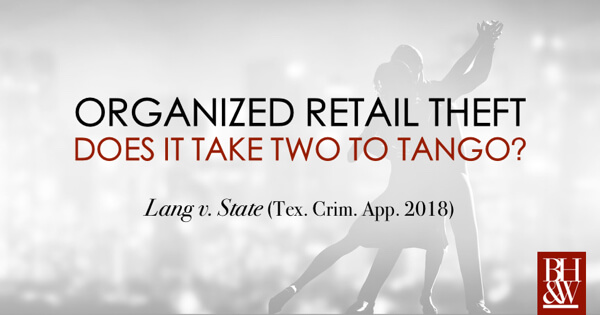
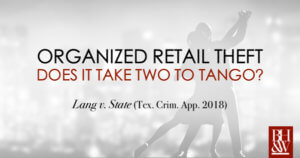 The Court of Criminal Appeals recently handed down an opinion on the applicability of Texas’ organized retail theft statute. The issue facing the court was whether the statute defining the offense of organized retail theft permits a conviction for ordinary shoplifting by a single actor rather than requiring a group or collaborative effort.
The Court of Criminal Appeals recently handed down an opinion on the applicability of Texas’ organized retail theft statute. The issue facing the court was whether the statute defining the offense of organized retail theft permits a conviction for ordinary shoplifting by a single actor rather than requiring a group or collaborative effort.
CCA Opinion: Lang v. State (Tex. Crim. App. 2018)
The Facts—Defendant Stole Merchandise from HEB and Was Convicted Under Texas’ Organized Retail Theft Statue.
Defendant was shopping at HEB when an employee noticed her placing merchandise into reusable shopping bags. Some of the bags were inside of Defendant’s cart and one was tied to the side of her cart. The employee thought this behavior was unusual, so she kept an eye on Defendant. When Defendant went to check out, the employee observed her place all but one of the reusable bags onto the conveyor belt—leaving the bag that was tied to the side of the cart untouched. After paying, Defendant began to leave the store. Defendant was subsequently stopped by employees and questioned about the bag that was tied to her cart, which was full of unpaid merchandise. The unpaid items totaled $565.59, whereas the paid-for merchandise totaled only $262.17. At that time, the store called the police and Defendant was eventually arrested, charged, and convicted of organized retail theft.
Defendant appealed her conviction arguing that the evidence was legally insufficient to support her conviction. More specifically, Defendant claimed that the offense of “organized retail theft” could not be committed by a single actor because the statute requires group action or collaborative effort. The court of appeals rejected this argument for the reasons listed below.
Court of Appeals Affirms the Trial Court’s Decision—Claiming that Organized Retail Theft Does Not Require Multiple Actors.
In making their decision the court of appeals looked to the statute’s language, which provides that a person commits an offense if she “intentionally conducts, promotes, or facilitates an activity in which the person receives, possesses, conceals, stores, barters, sells, or disposes of: (1) stolen retail merchandise; or (2) merchandise explicitly represented to the person as being stolen retail merchandise.” The court contended that nowhere in the statutory language was there explicit terms requiring group behavior. As a result, the court held that the language was not ambiguous and used plain meaning to interpret the statue.
Using dictionary definitions, the court concluded that the statutory terms “conducts, promotes, or facilitates,” did not require multiple actors. The court also explained that reading those statutory terms in context, established that what is conducted, promoted, or facilitated is an “activity,” not another person. Thus, “leaving the store after stealing the retail merchandise” was sufficient activity to meet the elements required by the statute. Accordingly, the court of appeals upheld the defendant’s conviction and another appeal ensued.
Court of Criminal Appeals Reverses and Remands Case—Determining that Organized Retail Theft Requires Multiple Actors.
On appeal Defendant maintained that the offense of organized retail theft could not be committed by a single actor. She did not dispute the facts, rather, as a matter of law, she disputed whether the facts were adequate to establish the offense of organized retail theft. To evaluate this argument the Court of Criminal Appeals analyzed the statute’s language and compared it with the court of appeals’ analysis and Defendant’s argument. In doing so, the Court determined that the language could reasonably be interpreted in more than one way, and therefore, extra-textual sources, such as legislative history must be considered.
To make this determination the Court looked at the statute’s use of the past participle of steal (e.g., “stolen”). The court explained that use of “stolen” indicated that the “activity” covered by the statute takes place with respect to items that have already been stolen. Thus, the question then becomes “what type of ‘activity’ suffices to satisfy the statute’s requirements.” “Is it enough, as the court of appeals suggested, for a person to shoplift items of retail merchandise and then attempt to leave the store with the stolen items, thereby conducting an activity (leaving the store) in which the person possesses the retail merchandise she has just stolen?” Or, as Defendant suggested, does the statute require proof of some activity distinct from the type of conduct associated with shoplifting? In other words, “does the statute require proof of something more than the mere continued possession of the stolen retail merchandise during an attempt to leave the store?” Not immediately knowing the answer to these two reasonable interpretations, the Court decided it had to look to legislative history to help find the right answer.
After examining the statute’s legislative history, the Court found that the organized retail theft statute was intended to reach conduct distinct from that of ordinary shoplifting. To support its decision, the Court cited the statute’s bill analysis and a senate research report. Both pieces of legislative history similarly stated that organized retail theft is a highly organized criminal activity, dependent on multiple actors, and organized by a central figure. Further, the sources stated that organized retail theft is distinct from ordinary shoplifting in that it involves professional theft rings that move quickly across state lines in order to steal and move large amounts of merchandise—requirements that are clearly not present during ordinary shoplifting.
As such, when considering the legislative history in conjunction with the ambiguous statutory language, the Court concluded that it supports the notion that the organized retail theft statute was not intended to apply to the conduct of an ordinary shoplifter acting alone but rather to multiple actors involved in highly organized theft rings. Thus, the Court reversed and remanded the case.

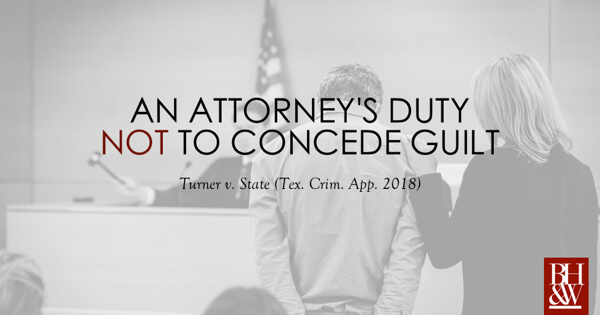
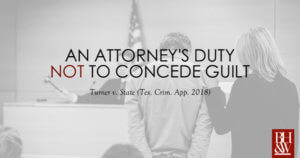 The Court of Criminal Appeals recently handed down an opinion regarding an attorney’s obligation not to concede their client’s guilt. The issue before the Court was whether the defendant was entitled to a new trial on direct appeal because his defense counsel conceded his guilt at trial against his wishes.
The Court of Criminal Appeals recently handed down an opinion regarding an attorney’s obligation not to concede their client’s guilt. The issue before the Court was whether the defendant was entitled to a new trial on direct appeal because his defense counsel conceded his guilt at trial against his wishes.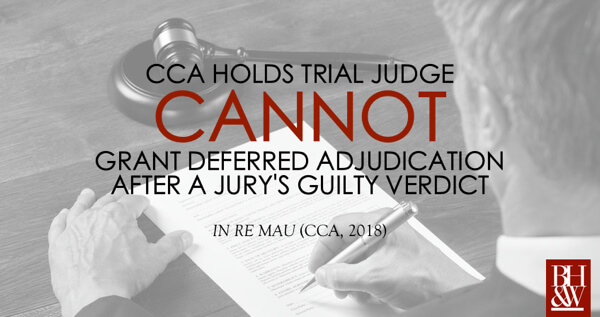
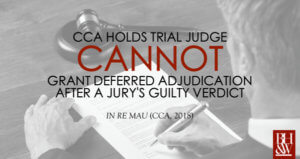 The Court of Criminal Appeals recently handed down an opinion on a petition for writ of mandamus. The two issues facing the court were (1) the nature of a misdemeanor trial after a defendant pleads guilty to a jury; and, (2) whether a trial court has the ability to defer an adjudication of guilt after a jury finds a defendant guilty. The Court of Criminal Appeals declined to grant mandamus relief on the first issue but, for the reasons discussed below, it granted mandamus relief for the second issue.
The Court of Criminal Appeals recently handed down an opinion on a petition for writ of mandamus. The two issues facing the court were (1) the nature of a misdemeanor trial after a defendant pleads guilty to a jury; and, (2) whether a trial court has the ability to defer an adjudication of guilt after a jury finds a defendant guilty. The Court of Criminal Appeals declined to grant mandamus relief on the first issue but, for the reasons discussed below, it granted mandamus relief for the second issue.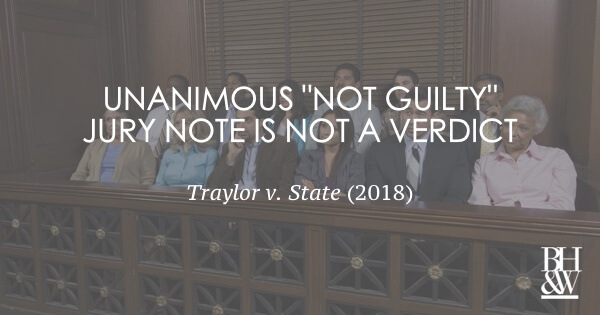
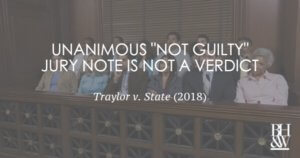 The Court of Criminal Appeals recently handed down an opinion regarding whether a jury can informally acquit based on a unanimous jury note. The issue facing the court was whether a jury note, which provided the jury’s voting breakdown of the charged offense and the lesser included offense, could be considered an acquittal for double jeopardy purposes even though a mistrial was later declared because the jury could not reach a unanimous decision.
The Court of Criminal Appeals recently handed down an opinion regarding whether a jury can informally acquit based on a unanimous jury note. The issue facing the court was whether a jury note, which provided the jury’s voting breakdown of the charged offense and the lesser included offense, could be considered an acquittal for double jeopardy purposes even though a mistrial was later declared because the jury could not reach a unanimous decision.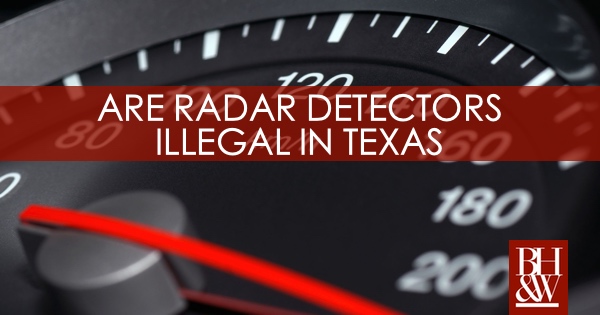
 Lets face it, most of us have received a speeding ticket at some point in our lifetime. As a result, radar detectors have become commonplace for drivers that want to take preventative measures to avoid receiving a ticket. Such preventative measures bring up an important question: are radar detectors illegal? Can I get a ticket for using a radar detector?
Lets face it, most of us have received a speeding ticket at some point in our lifetime. As a result, radar detectors have become commonplace for drivers that want to take preventative measures to avoid receiving a ticket. Such preventative measures bring up an important question: are radar detectors illegal? Can I get a ticket for using a radar detector?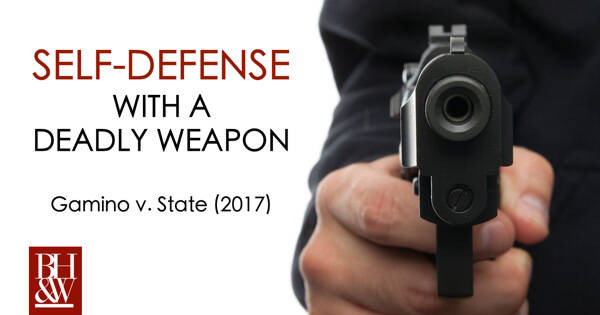
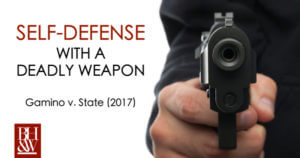 The Court of Criminal Appeals recently released an opinion regarding when a defendant is entitled to a self-defense charge. The issue facing the Court was whether there was some evidence, from any source, that would support the elements of self-defense and whether self-defense was authorized when a deadly weapon was used in response to verbal provocation.
The Court of Criminal Appeals recently released an opinion regarding when a defendant is entitled to a self-defense charge. The issue facing the Court was whether there was some evidence, from any source, that would support the elements of self-defense and whether self-defense was authorized when a deadly weapon was used in response to verbal provocation.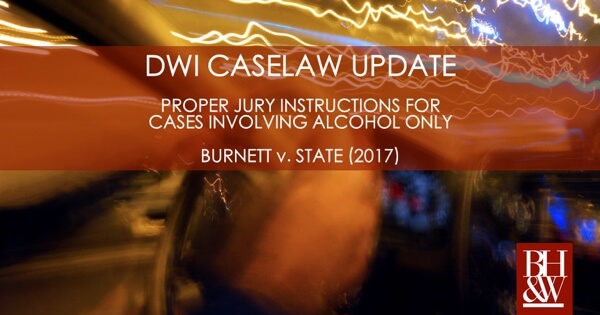
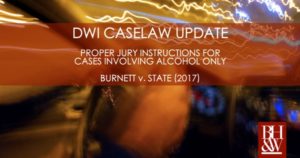 The Court of Criminal Appeals recently handed down a case regarding the State’s ability to use the full statutory definition of “intoxicated” in a jury charge for DWI cases. The issue faced by the court was whether the trial court erred in providing the jury with portions of the statutory language that were not supported by evidence presented at trial.
The Court of Criminal Appeals recently handed down a case regarding the State’s ability to use the full statutory definition of “intoxicated” in a jury charge for DWI cases. The issue faced by the court was whether the trial court erred in providing the jury with portions of the statutory language that were not supported by evidence presented at trial.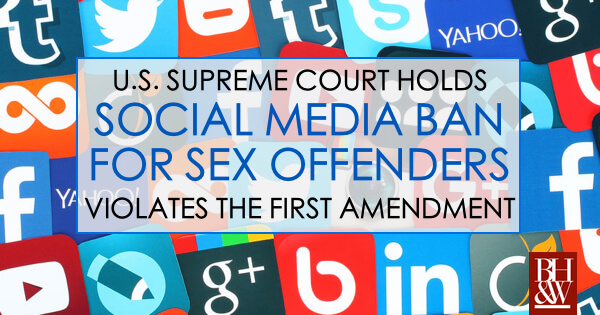
 In today’s world Internet access has become virtually unlimited. And, with new technology come new problems. These problems have led the Supreme Court to address the challenge modern day Internet access has created for the First Amendment in the landmark case,
In today’s world Internet access has become virtually unlimited. And, with new technology come new problems. These problems have led the Supreme Court to address the challenge modern day Internet access has created for the First Amendment in the landmark case, 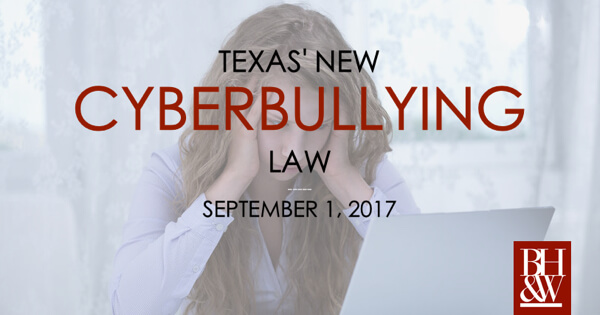
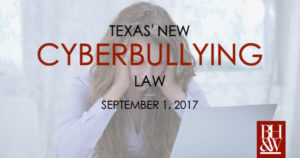 On June 9, 2016, the
On June 9, 2016, the 
 Virtually every state in America has a statewide law banning the use of cell phones or texting while driving. Until recently, Texas has had minimal restrictions on cell phone usage while driving. Such restrictions include:
Virtually every state in America has a statewide law banning the use of cell phones or texting while driving. Until recently, Texas has had minimal restrictions on cell phone usage while driving. Such restrictions include:





